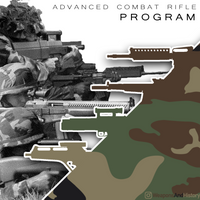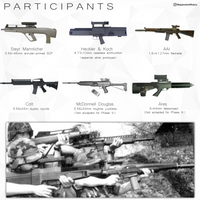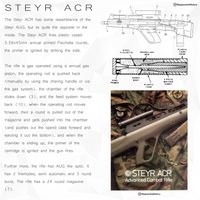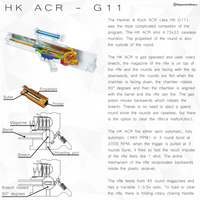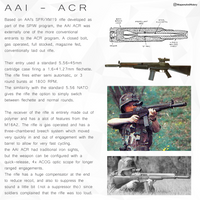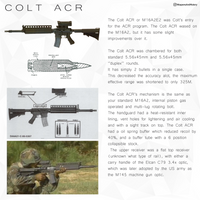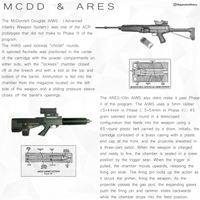The Advanced Combat Rifle program
The Advanced Combat Rifle (ACR) was a United States Army program, started in 1986, to find a replacement for the M16 assault rifle. Under the stress of battle the average soldier with an M16 may shoot a target at 45 meters, but hit probability is reduced to one out of ten shots on target by 220 meters. Because of this, the ACR program was initiated in the late 1980s to create a weapon that could double the hit probability. The program ended in 1990 and the U.S. army sticked to the M16.
Phase I of the program started in February 1986 when development contracts were placed with six companies: AAI Corporation, Ares Incorporated, Colt's Manufacturing Company, Heckler & Koch, McDonnell Douglas Helicopter Systems, and Steyr.
Two weapons were cut from the list before Phase II started.
Phase III began in August 1989, when AAI, Colt, HK, and Steyr entered weapon testing
Although all the designs worked well, none managed to meet the 100% improvement over the M16A2 that the program demanded. In 1986/7, the United States Army Infantry School had published a report asserting that the rifle, had already reached its peak, and the only way to really improve was to use an exploding warhead. This led to the ending of the program in April 1990, and led the way to the Objective Individual Combat Weapon program.
The Participants:
Steyr, Heckler & Koch, AAI, Colt, McDonnel Douglas and Ares.
Steyr
The Steyr ACR has some resamblance of the Steyr AUG, but its quite the opposite in the inside. The Steyr ACR fires plastic cased 5.56x45mm annual primed Flechette rounds, the primer is ignited by striking the side. The rifle is gas operated using a annual gas piston, the operating rod is pushed back (manually by using the charing handle or via the gas system), the chamber of the rifle slides down (3), and the feed system moves back (10), when the operating rod moves forward, then a round is pulled out of the magazine and gets pushed into the chamber (and pushes out the spend case forward and ejecting it out the bottom), and when the chamber is sliding up, the primer of the cartridge is ignited and the gun fires. Further more, the rifle has AUG like optic. It has 2 firemodes, semi automatic and 3 round burst. The rifle has a 24 round magazine (7).
Heckler and Koch
The Heckler & Koch ACR (aka HK G11) was the most complicated competitor of the program. The HK ACR shot 4.73x33 caseless munition. The propellant of the round is also the outside of the round. The HK ACR is gas operated and uses rotary breech, the magazine of the rifle is on top of the rifle and the rounds are facing with the tip downwards, and the rounds are fed when the chamber is facing down, the chamber rotates 90° degrees and then the chamber is aligined with the barrel and the rifle can fire. The gas piston moves backwards which rotates the breech. Theres is no need to eject a spend round since the rounds are caseless, but there is the option to clear the rifle(a malfunction). The HK ACR fire either semi automatic, fully automatic (460 RPM) or 3 round burst at 2000 RPM, when the trigger is pulled at 3 rounds burst, it fires so fast the recoil impulse of the rifle feels like 1 shot. The entire mechanism of the rifle reciprocates backwards inside the plastic receiver.
The rifle feeds from 45 round magazines and has a Variable 1-3.5x optic. To load or clear the rifle, there is folding rotary charing handle.
AAI
Based on AAI's SFR/XM19 rifle developed as part of the SPIW program, the AAI ACR was externally one of the more conventional entrants to the ACR program. A closed bolt, gas operated, full stocked, magazine fed, conventionally laid out rifle. Their entry used a standard 5.56×45mm cartridge case firing a 1.6×41.27mm flechette. The rifle fires either semi automatic, or 3 round bursts at 1800 RPM. The similairity with the standard 5.56 NATO gives the rifle the option to simply swtich between flechette and normal rounds. The receiver of the rifle is entirely made out of polymer and has a alot of features from the M16A2. The rifle is gas operated and has a three-chambered breech system which moved very quickly in and out of engagement with the barrel to allow for very fast cycling. the AAI ACR had traditional iron sights, but the weapon can be configured with a quick-release, 4x ACOG optic scope for longer ranged engagements. The rifle has a huge compensator at the end to reduce recoil, and also to suppress the sound a little bit (not a suppressor tho) since soldiers complained that the rifle was too loud.
Colt
The Colt ACR or M16A2E2 was Colt’s entry for the ACR program. The Colt ACR wased on the M16A2, but it has some slight improvements over it.
The Colt ACR was chambered for both standard 5.56x45mm and 5.56x45mm ‘’duplex’’ rounds.
It has simply 2 bullets in a single case.
This decreased the accuracy alot, the maximum effective range was shortened to only 325M.
The Colt ACR’s mechanism is the same as your standard M16A2, internal piston gas operated and multi-lug rotating bolt.
The handguard had a heat-resistant inner lining, vent holes for lightening and air cooling and with a sight track on top. The Colt ACR had a oil spring buffer which reduced recoil by 40%, and a buffer tube with a 6 position collapsible stock.
The upper receiver was a flat top receiver (unknown what type of rail), with either a carry handle of the Elcan C79 3.4x optic, which was later adopted by the US army as the M145 machine gun optic.
McDonnel Douglas
The McDonnell Douglas AIWS (Advanced Infantry Weapon System) was one of the ACR prototypes that did not make to Phase III of the program. The AIWS used lockless "chiclet" rounds. A saboted flechette was positioned in the center of the cartridge with the powder compartments on either side, with the "lockless" chamber closed off at the breech end with a slot at the top and bottom of the barrel. Ammunition is fed into the chamber from the magazine located on the left side of the weapon and a sliding pressure sleeve closes off the barrel’s openings.
Ares
The ARES-Olin AIWS also didnt make it past Phase II of the program. The AIWS uses a 5mm caliber (5×44mm in Phase I, 5×54mm in Phase II), 45 grain saboted tracer round in a telescoped configuration that feeds into the weapon using a 65-round plastic belt carried by a drum. Initially, the cartridge consisted of a brass casing with a plastic end cap at the front, and the projectile sheathed in a three-part sabot. When the weapon is charged and ready to fire, the chamber is sealed in a lower position by the trigger sear. When the trigger is pulled, the chamber moves upwards, releasing the firing pin slide. The firing pin locks up the action as it struck the primer, firing the weapon. As the projectile passes the gas port, the expanding gases push the firing pin and rammer slides backwards while the chamber drops into the feed position.
